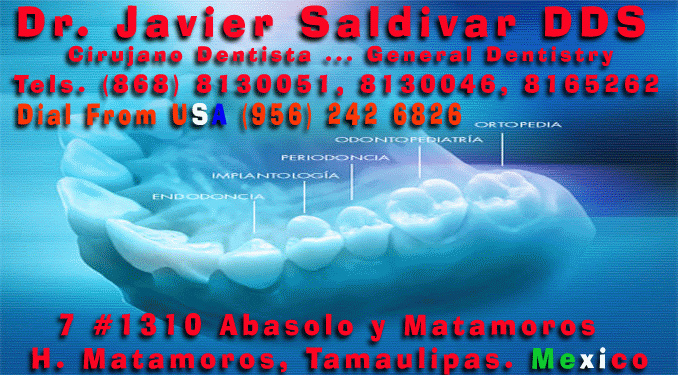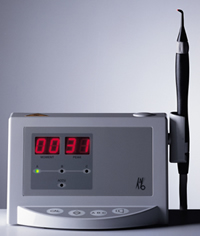
|
|
|
DIAGNO dent Diagnostico de la caries con LASER
|
||||
Cuál es la base científica de DIAGNOdent?
Un diodo de
luz láser proporciona un haz de luz de longitud de onda definida que es
dirigida hacia el diente. Cuando la luz incidente encuentra un cambio en
la sustancia dentaria rebota de la misma un haz de luz fluorescente de
distinta longitud de onda. |
||||
Los beneficios:
|
||||
|
Actualidad DIAGNOdent ofrece el más alto grado de sensibilidad diagnóstica. En una prueba llevada a cabo por un grupo de odontólogos para el diagnóstico visual de las caries el correcto diagnóstico de las caries iniciales únicamente fue logrado en el 57% de los casos cuestión que se elevó al 90% gracias al uso de DIAGNOdent de KaVo. (Fuente: Dr. A. Lussi form Berne University).
|
||||
|
Con la aplicación y uso de DIAGNOdent de KaVo el doctor puede realizar un diagnóstico precoz sin necesidad de someter al paciente a repetidas y nocivas exposiciones a radiológicas. Dos diseños de puntas diagnósticas
El ligero peso de la pieza de mano permite un manejo sencillo y fácil por el operador. |
|
|
|||||||
|
||||
Diagnodent is a pen-like probe that sends a safe,
painless laser beam into the tooth. A numeric display & alarm
signals when there are signs of hidden decay.
These pictures show how the Diagnodent finds cavities that other dental instruments can miss.How it works....
Over 90% accurate!Proportion of "correct diagnoses" using various diagnostic methods (in the case of seemingly intact occlusal - biting surfaces). In a study conducted by Dr. Lussi of Berne University, Switzerland, dentists correctly diagnosed hidden fissure areas by visual inspection in only 57% of all cases.
The same group achieved an impressive success rate of 90% with the DIAGNOdent. In fact, DIAGNOdent was far more accurate than any other method in the study including bitewing x-rays (flossing x-rays) . |
DIAGNOdent by KaVo
 DIAGNOdent
uses a small laser to accurately locate decay, as well as areas prone to
decay. Studies show that DIAGNOdent is more accurate than X-rays, and it
emits no radiation because it is not taking an image, but rather
scanning the teeth. The process is completely comfortable and requires
no anesthesia.
DIAGNOdent
uses a small laser to accurately locate decay, as well as areas prone to
decay. Studies show that DIAGNOdent is more accurate than X-rays, and it
emits no radiation because it is not taking an image, but rather
scanning the teeth. The process is completely comfortable and requires
no anesthesia.
Conservative dentistry is always the best option for patients. When we find decay early, teeth incur less damage and more natural tooth structure can be retained during restoration. DIAGNOdent can also find areas prone to future decay. Demineralization in teeth makes them susceptible to decay. By re-mineralizing with fluoride, patients may deter cavity formation. Our team believes prevention is best for the patient because it will reduce your need for future reconstructive dental procedures. Modern advances in dentistry, like DIAGNOdent, allow us to give you the most conservative and precise treatment available, and you deserve it. Now that’s something to smile about!
 DIAGNOdent
DIAGNOdent
Finding Difficult Decay The Easy Way
One of the most important things we do for our patients is to identify cavities and restore teeth. Since any spot of decay can threaten the integrity of an entire tooth, this is key to preventing a host of future problems. Historically, that’s why lengthy poking and prodding sessions have been an acceptable, if not very comfortable, part of dental exams. However, such methods of decay detection are only 50% to 75% successful: cavities can hide along fissure lines, or inside biting or occlusal surfaces. Further, mechanical exploratory methods are limited to finding only those cavities that are equal to or larger than the probe head. Enter DIAGNOdent: a revolutionary, thorough means of detecting cavities.
Laser Reflection Spots Imperfection
DIAGNOdent technology uses a laser diode to inspect your teeth, comparing reflection wavelength against a healthy baseline wavelength to uncover decay. First, we take a benchmark reading by aiming the laser onto one of your healthy enamel tooth surfaces, then we shine the laser into all suspect areas. As it pulses into grooves, fissures and cracks, the laser reflects fluorescent light of a specific wavelength which is measured by receptors, converted to an acoustic signal, evaluated electronically to reveal a value between one and 100, and then displayed on a screen. Any variation from the healthy baseline value stimulates emission of a different wavelength and alerts us to a weakened area of decay. Not surprisingly, this technology quickly and precisely identifies even the tiniest bit of decay. This means shallower, simpler fillings, preserving more tooth structure, and providing a specific mean of monitoring suspicious areas without repeated x-rays.

Frequently Asked Questions
Q: Does it hurt?
A: No! DIAGNOdent is completely painless. It’s energy level similar to that of a laser pointer, the laser beam is harmless to surrounding tissues.
Q: What are the shortcomings of the traditional dental techniques like probing and x-ray imaging?
A: Believe it or not, as much as 50% of tooth decay may go undetected by traditional dental methods of probing and other diagnostic techniques.
Q: How long has this technology been around?
A: While the device has been in use in Europe for several years, the FDA has recently approved the use of the cavity-detecting laser for use by dentists in the U.S.A.
Q: Where does most tooth decay start today?
A: Today most tooth decay starts in the hard-to-see valleys and canyon-like anatomy of the tooth surface.
Q: Why are these pit and valley cavities more important to detect today than in the past?
A: In the past tooth decay predominated in between teeth. With the widespread use of fluoride, the very nature of tooth decay has changed. The outer surfaces of teeth are strengthened and more resistant. Today the pit and valley cavities are more prevalent than cavities in between teeth.
Q: Why can’t traditional methods like x-rays see these pit and valley cavities?
A: Pit and valley cavities are traditionally the most difficult to detect using x-rays due to the direction the images are taken from. Images are taken from the side of the tooth, which essentially hides the cavity from the dentists view.
Q: If DIAGNOdent is good at finding pit and fissure cavities do I still need x-rays?
A: Yes, x-ray imaging is an indispensable diagnostic tool for dentistry. X-rays and DIAGNOdent complement each other. X-rays are good at finding cavities in between teeth and on the roots. DIAGNOdent is good at find cavities on the tooth’s biting surface.
Q: If you can’t see it with your naked eye then why should one be concerned?
A: An almost undetectable area of decay can aggressively penetrate inward towards the soft surfaces of the tooth and literally destroy the tooth from the inside out. This can happen before a cavity is even visible to the naked eye.
Q: Why can’t traditional methods like the dental probe (pick) find these pit and valley cavities?
A: This type of decay can make diagnosis with traditional methods difficult because the outer tooth surface often appears to be intact and the probe may be too large to detect the cavity.
Q: How does DIAGNOdent work?
A: DIAGNOdent is first calibrated to your unique tooth structure by scanning a cleaned tooth surface with a harmless laser beam. After calibration a team member will gently scan your teeth. A small countertop unit emits an audio signal and registers a digital read-out, which identifies cavities developing below the surface –the higher the amount of fluorescence detected by the machine, the greater the degree of decay within the tooth.
Q: What is the benefit to me?
A: Because the decay is detected earlier, the number of dental procedures - and hence, the cost - can often be reduced. It’s a great way to keep little problems from becoming big problems.
Q: How long does the DIAGNOdent process take?
A: A few minutes are all it takes to scan your entire mouth.
Q: How much does it cost?
A: Dr.Javier Saldivar uses the DIAGNOdent laser as a routine part of exams and there is additional fee associated with the scan.($10.00 DLLS)
Q: What is the DIAGNOdent actually measuring?
A: The DIAGNOdent measures laser fluorescence within the tooth structure. As the incident laser light is propagated into the site, two-way handpiece optics allows the unit to simultaneously quantify the reflected laser light energy. At the specific wavelength that the DIAGNOdent laser operates, clean healthy tooth structure exhibits little or no fluorescence, resulting in very low scale readings on the display. However, carious tooth structure will exhibit fluorescence, proportionate to the degree of caries, resulting in elevated scale readings on the display.
Q: Can DIAGNOdent be used around existing composite resin restorations?
A: No. Because composite resins can fluoresce, prompting elevated readings, the DIAGNOdent should not be used on these materials.
Q: Can DIAGNOdent read caries under an existing amalgam?
A: If there is caries at the margin, it will give an accurate reading; however if the caries is under the floor of the amalgam the reading will not be accurate.
Q: Can DIAGNOdent be used on both primary and permanent teeth?
A: Studies have shown the unit is equally accurate in both primary and permanent teeth.
Q: As the device is a laser, is protective eyewear required?
A: No. The device is harmless when used as directed.
Copyright © 2016 Dr.Javier Saldivar V.
All Rights Reserved.
Reproduction or
republication strictly prohibited without prior written permission.